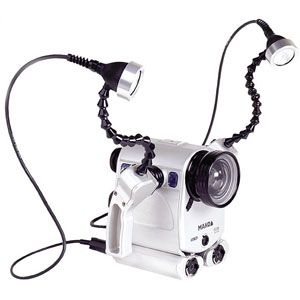Camera
I myself use a Sony DCR-PC100E, which has the above mentioned features. The Carl-Zeiss lens is extremely bright and produces excellent results even under unfavourable conditions, i. e. little light.
Admittedly, a price of €2,000 is not a small price to pay, but the camera still performs well today.
As an accessory, a larger battery pays for itself. The camera therefore does not have to be recharged after every dive, which means that the underwater housing has to be opened. This increases the risk of dust particles or hair getting onto the O-ring and the camera' flooding'. Note: the less the underwater housing is opened, the better.
Lighting
There are various types of lighting units, but it is important to use at least two lamps for filming. That way you avoid too many shadows. Ideally, both lamps can be controlled independently to create special effects. The light spectrum of the burners should be as high as possible (5000° Kelvin correspond to natural sunlight). In the amateur sector, values between 3500° and 4000° Kelvin are common.
 Three systems are usually used:
Three systems are usually used:
- Two completely separate lamps, each with its own operation
Advantage: both lamps can be controlled separately from each other
Disadvantage: higher weight and two chargers (if you want to charge both lamps at the same time) necessary. - Two lamps, one battery tank with central control
Advantage: less weight and only one charger (less cost, less travel weight)
Disadvantage: no separate operation possible. - Two lamps, one battery tank with separate operation (usually on/off button)
Advantage: as above
Disadvantage: none, this is probably the most ideal solution.
In any case, the brightness of the lamps must be adjustable. During a night dive less light is needed, because the camera works in' night mode' due to the darkness and would therefore be over-exposed very quickly, furthermore the sleeping animals are spared.
As soon as batteries and lamps come into play, this immediately strikes the weight of the equipment and you have to generate additional lift with buoyancy bodies. If you don't do this, it will be difficult to align the camera to the object, and an unbalanced camera will also affect your own taring.






